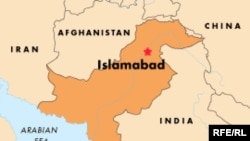Pakistan's President Pervez Musharraf said yesterday that Rabia was killed in the tribal area of North Waziristan -- probably on 1 December. "Yes indeed, 200 percent confirmed," he said. "It was in one of our [tribal] agencies, North Waziristan agency. It's a place called Mir Ali town. A little north of this town. That is the place. And I think he was killed [on 1 December]."
U.S. and Pakistani intelligence officials say Rabia's remains were identified by DNA tests. He was believed to be an Egyptian national responsible for planning Al-Qaeda terrorist attacks outside of the Pakistan- Afghanistan region. Rabia also was thought to be responsible for Al-Qaeda's training, recruiting, and networking operations.
But the exact circumstances of Rabia's death remain unclear. Senior Pakistani intelligence officials who have spoken to journalists on condition of anonymity initially said a U.S. missile attack triggered a huge explosion within a stockpile of bomb-making materials, grenades, and other munitions. They also said that U.S. assistance played a critical role in tracking down Rabia and "eliminating the threat" that he posed.
That has led some analysts to suggest that an attack was carried out by an unmanned U.S. Predator drone plane. That aircraft has surveillance cameras and can be operated by remote control to shoot a missile at targets on the ground.
But the official story being told by Pakistan's Information Ministry today is that Rabia died in an explosion he caused himself while making bombs inside of a building. "That is the information that we have -- that probably it was an accidental explosion that resulted in his death," Pakistani armed forces spokesman Major General Shaukat Sultan said.
Rabia was a key associate of Al-Qaeda's second in command, Ayman al-Zawahri. U.S. intelligence officials say Rabia filled a power vacuum created earlier this year by the capture of the previous operations chief, Abu Faraj al-Libbi.
They say Rabia had a wide array of jihadist contacts and was believed to be trying to reinvigorate Al-Qaeda's international operations.
A photograph has emerged from the village where Rabia died. It shows villagers holding up a piece of metal from a U.S. missile. But the authenticity of that photograph has not been confirmed. And while a close-up of the metal fragment shows English words, all identification numbers that could confirm the missile type have been scratched off.
Still, some independent defense analysts note that the United States has used drone planes in the past to launch missiles at suspected Al-Qaeda targets. They say that if past performance can be used to predict current antiterrorism operations, then the use of a U.S. missile was likely.
In Washington, neither the Pentagon nor the White House would offer immediate comment about the reports of U.S. involvement. Some U.S. intelligence officials would say only that the issue was a sensitive one for Paksitan's government.
Meanwhile, reports say assailants fired at least four rockets overnight in the area of Mir Ali where Rabia died. No injuries were reported. But one rocket hit a power line, disrupting electricity to several villages in the area.






